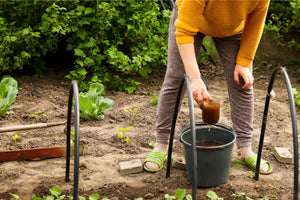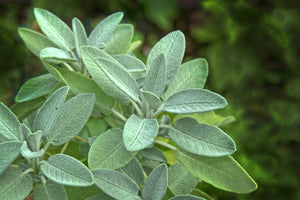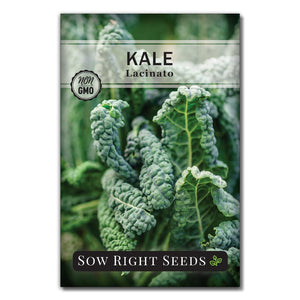Start Growing Lettuce from Seed for Crisp, Fresh Salads
Leafy greensLettuce is one of the easiest vegetables to grow and is perfect for beginner gardeners. Lettuce seeds are quick to germinate, and the leaves grow fast. Within six weeks, you can be picking leaves for a crisp salad. Follow these simple steps to start growing fresh lettuce in your home garden.

How to Grow Lettuce from Seed
We sow lettuce seeds in our fall garden and enjoy a fresh harvest until the first freeze. In our spring garden, lettuce will be the first thing we sow. We recommend it to all first-time gardeners.
Lettuce seeds can be started indoors and then transplanted or sown directly outdoors. The benefit of starting lettuce seeds indoors is that you can protect the tender seedlings from extreme temperatures. For a fall crop, you can start lettuce seeds indoors in late summer and then transplant them after the last heat wave. In the spring, you can have lettuce seedlings ready to be transplanted outdoors when the temperatures are ideal.

To start lettuce seeds indoors for transplanting:
Sow seeds 3-4 weeks before the desired transplanting date.
Use growing cells and plant 2 to 3 seeds per cell.
Plant seeds ¼” deep in seed starting mix.
Use a spray bottle to moisten the soil.
Keep the seeds moist until they germinate in 7-10 days.
Once seedlings are large enough, they can be transplanted outdoors. Lettuce seedlings should be several inches tall with multiple leaves.
Before transplanting them outdoors, take 2 or 3 days to harden off lettuce seedlings.
To start lettuce seeds outdoors:
Lettuce seeds can be sown outdoors as soon as the soil is workable.
Soil temperature of 50-65ºF is the optimal range.
Plant seeds ¼” deep in fertile, well-draining soil.
Keep soil moist but not waterlogged.
Thin lettuce seedlings to 8-10 inches apart.

How to Grow Lettuce Plants
Lettuce plants are easy to grow and maintain. They are the perfect crop for beginner gardeners and can be grown in small spaces. Even if you only have a balcony, you can enjoy the delicious taste of crisp, homegrown lettuce. Follow these lettuce growing basics for a successful fresh harvest.
Sun
Lettuce can be grown in full sun when it’s not too hot. But some shade will help to keep it cool. Lettuce will need at least 6 hours of sunlight daily.
Soil
Rich, fertile soil that drains well is the best for growing lettuce. Keep the soil consistently moist. We like growing lettuce in our raised beds. This also helps to keep out the rabbits. You can amend your soil with well-rotted compost before planting.
Water
Water lettuce at the root area while aiming to keep the leaves dry. Drip irrigation works well for watering lettuce. Typically, lettuce will need 1 inch of water a week. However, more frequent watering may be required in dry climates or sandy soil.
Fertilizer
Lettuce grows fast and doesn’t usually need fertilizer when grown in nutrient-rich soil. Nitrogen does help leaves grow, and a slow-release fertilizer can be added to the soil before transplanting.
Spacing
Lettuce seeds are so tiny that it’s difficult to space the seeds far enough apart. Thinning the seedlings to a proper spacing will give them room to grow without competition. Cutting these tender plants with small scissors is the best way to thin them. This will prevent disturbing the other plant roots. Space lettuce plants 8 to 12” apart, depending on the variety.
Succession Planting
Succession planting every 2 to 3 weeks is an excellent way to lengthen your lettuce harvest. You’ll have enough leaves to harvest each week without having it all at the same stage at the same time.
Companion Planting
Lettuce companion planting can be beneficial in several ways. One benefit of companion planting is to control pests. Sweet alyssum and other flowers will attract beneficial insects that eat aphids. Another advantage of companion planting is to provide lettuce with shade and soil nutrients. Planting lettuce with tomatoes, pole beans, and other crops can give them shade as they grow. Legumes will add nitrogen to the soil and make a great companion plant.
Intercropping
As the summer garden slows down, you can interplant lettuce. You can intercrop lettuce plants when you remove warm-weather crops that have stopped producing. These cool-weather crops will fill the space and appreciate the lower temperatures.
Bolting
Hot, dry summers will eventually take their toll on lettuce. When temperatures rise above 80ºF, lettuce will bolt and go to seed. When lettuce goes to seed, it stops producing new leaves. Keeping plants cool and shading them can prevent them from bolting too soon. When lettuce goes to seed, its flavor changes, and it develops a bitter milky sap. You can wait until fall to plant your next crop of lettuce.
Heirloom Lettuce Varieties
There are many varieties of lettuce to choose from. Planting a mix of colors and types will give you a beautiful and delicious array of leaves for salads and sandwiches.
Choose the right lettuce variety for your growing conditions. Jericho lettuce can handle the hot weather, and Lolla Rosa is excellent for hydroponics and indoor gardens. Leaf lettuces such as Heirloom Blend are perfect for container gardening.
Harvesting Lettuce
There are different ways to harvest lettuce depending on whether you are growing head or leaf lettuce.
Head Lettuce vs. Loose Leaf Lettuce
Head lettuce grows leaves in a tight head, while leaf lettuces spread out their leaves as they grow.
Leaf lettuce can be harvested just a few leaves at a time, which makes it an excellent choice for beginners and indoor gardens. As soon as the leaves are several inches high, you can remove the outer leaves, and the inner ones will continue to grow. Eventually, the lettuce plant will stop producing new leaves, and it can be removed and another vegetable grown in its place. Leaf lettuce can also be cut all at once if desired.
Head lettuce is harvested as the whole head. While the head is still forming, you can remove some of the outer leaves. Once the head is fully formed, you can cut off the head at the soil surface.
Rinse harvested lettuce in a sink or bowl of cold water. Shake off the water or use a salad spinner to remove most of the water. Then, store the lettuce in the fridge. The sooner you eat it, the better it is! But the cold temperature and some moisture will help lettuce stay crisp for about seven days.

Solutions for Lettuce Pests and Diseases
Aphids
Is there anything aphids don’t attack? Using natural methods to fend off aphids is important as lettuce leaves are tender. Also, you don’t want to put toxic chemicals on something you eat fresh.
Slugs & Snails
These slimy creatures thrive in the moist environment with leaves close to the ground. Use baits and removing them by hand can keep slugs and snails from destroying your fresh lettuce. Also, transplanting lettuce seedlings will give you a growing head start before slugs and snails find them.
Rabbits
Rabbits absolutely love lettuce! Placing physical barriers around your lettuce patch will be the best rabbit deterrent.
Fungus
White mold and powdery mildew are types of fungus that can infect lettuce plants. Good air circulation, morning watering, and destroying infected plants can help mitigate problems.
FAQs about Lettuce
What’s the difference between Leaf Lettuce and Head Lettuce?
Head lettuce grows leaves in a tight head, while leaf lettuces spread out their leaves as they grow. Within those two groups are many varieties of leaf lettuce and head lettuce.
Is lettuce frost-tolerant?
Lettuce is frost tolerant for the outer leaves. The lettuce plant will die once the temperatures drop low enough and long enough to freeze the inner core.
How long does it take to grow lettuce from seed?
The variety and growing conditions determine how fast lettuce grows. Generally, you can start harvesting the outer lettuce leaves around six weeks.
Can you grow lettuce in hydroponic gardens?
Loose-leaf lettuce varieties are excellent for hydroponic gardening. We recommend growing Lolla Rosa and Little Gem in a hydroponic garden.
Will lettuce grow back after cutting?
Lettuce can grow back if it is cut right. The plant will keep growing leaves as long as the inner core isn’t cut or damaged.
Can lettuce be grown in pots?
Lettuce is a beautiful plant to grow in pots, raised beds, and container gardens. Keep the soil moist and the plants cool for a healthy harvest.
We love growing lettuce and recommend it to all gardeners. Beginner, balcony, and even indoor gardeners can all enjoy a fresh and easy lettuce harvest. Try these colorful and delicious heirloom varieties and add lettuce to your garden plan.
Written by Beverly Laudie
Found this information helpful? Share it with your gardening friends!








Leave a comment